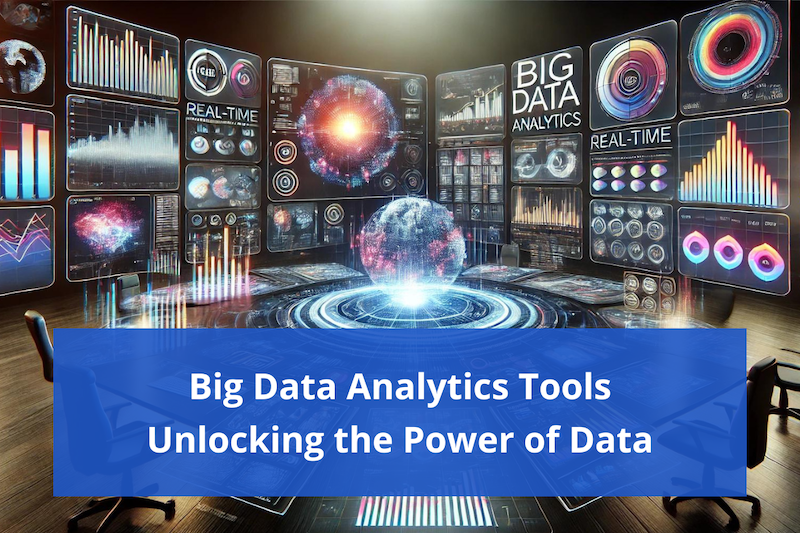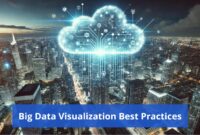There is tremendous growth in data in the contemporary age and organizations so out for ways to collect, organize and extract benefits out of the data collected. This is where big data analytics tools come into play, changing the whole paradigm of large data processing by companies. With their assistance, a company can extract particulars that can assist in making better choices, enhancing user satisfaction, and developing the company.
In the modern day, with the amount of data generated every second, using big data is not an option. It is a requirement. Companies in every industry from health care to retail turn to big data analytics tools to give them a competitive advantage. Such tools enable institutions to make use of the wealth of data at their disposal, identify patterns that lie in the text and aid in taking major business decisions.
What are Big Data Analytics tools?
Big Data analytics tools are typically software applications and /or platforms used to support organizations in the process of collecting, garnering and conceptually examining, and operationalizing structured and unstructured work protocol.
These tools integrate multiple types of data social networks, websites, human sensors and others, in order to generate you useful data. Advancements in technology brought about changes in traditional data processing systems, the changes brought about new, faster and multicore based systems.
Such tools have become so affordable and sophisticated because of the growth in the use of cloud computing and advanced algorithms. Their purpose has been extended by companies who use them to optimize processes, analyze consumers, as well as forecast trends and cut down on expenses.
The Benefits in Using Big Data Analytics Tools
Business enterprises adopt tools of Big Data analytics for various reasons. Some of these benefits include:
- Better Decision Making: There are numerous decision making insights that can be derived from data mining big data sets.
- Better Customer Understanding: Marketing and product development becomes effective with Big Data, as marketing tools track the ideologies and behaviours of customers.
- Better Business Operations: Disorganizing works and waste in firms can also be avoided using these tools, which analyses facts and allows these processes to be unified.
- Predictive Analysis: Not all Big Data analytics tools are created equal but many do offer predictive analysis tools which use simple machine learning algorithms which can help With prediction based on historical events.
- Reduced Expenses: The manual processes that most companies conduct when managing their data costs a lot in terms of resources but with data advancing technology, there is an increase in the computerization of these activities therefore leading to low costs.
Key Features of Big Data Analytics Tools
Business Intelligence Tool use principles of Big data analytics tools although individual analytics tools may be different in functionalities, they all come with certain critical characteristics necessary for business:
- Scalability: The ability to increase the amount of data with ease.
- Data Integration: Such systems have to interoperate with several data sources and formats both structured and non-structured.
- Real-Time Analytics: Providing intelligence as an event occurs by processing information as it is generated, that is, providing promptly required information.
- Data Security: Safeguarding sensitive matter through proper confidentiality and legal fragmentation.
- Customization: A number of tools provide reporting and dashboard facility with advanced features for performing organizations.
These features ensure that businesses are fully capable of getting the best out of their data to the fullest, irrespective of how big or complex the data is.
Types of Big Data Analytics Tools
Big Data analytics tools do fall into different categories but for the purposes of this report consider two categories depending on how data is processed.
- Real-Time Processing Tools: These tools are used to analyze incoming data upon its emission. They best suit commercial entities that make instant conclusions from current data for instance the financial and or e-tail companies. Some common tools used in this category are Apache Kafka and Flink.
- Batch Processing Tools: These Tools are defined for analysis of enormous data quantities That is done over specified periods. They are ideal for analysing periods that are in the past hence effective for analyzing such trends that go further back in time. Tools like Hadoop and Apache Spark are prime examples of batch processing tools.
A firm that knows the features of the tools on offer will be in a position to choose the most appropriate tool in terms of the task expected from it.
Popular Open-Source Big Data Analytics Tools
Seeking business software at a low price has led to the growing use of open-source software among people. A few of the widely used open source Big data analytics tools are written here:
- Hadoop: One of the first in the Big Data World, Hadoop’s purpose is to allow the processing of large data sets in a distributed fashion across a Hadoop clusters.
- Apache Spark: Spark is known for speed and processes the information instantaneously which allows for information streaming.
- Elasticsearch: The tool is efficient in interrogating vast quantities of data as it allows for a fast full text search over a large database.
These tools have a strong developer base and thus are continuously developed to access into the market needs.
Cloud-Based Big Data Analytics Tools
Cloud computing has changed the way big data analytics is done. The cloud based tools come with several advantages over on premises such as growth, flexibility and low infrastructure expense ratios. The leading cloud based big data analytics platforms featured are:
- Amazon Web Services: (AWS) Some services like Redshift and EMR offered by AWS makes it easier for businesses to analyze big volumes of data.
- Google Cloud Platform: (GCP) Data analysis using GCP’s BigQuery is simple since it’s a fast data warehouse with ease in handling large data sets in real time.
- Microsoft Azure: There are vast amounts of data processing done on the cloud using tools such as Azure Synapse Analytics.
Such platforms help organizations in increasing the scale of the data operations without any compromise on data security and integrity.
Big Data Visualization Tools
Visualization is also a major component of Big Data analytics as it helps in converting large amounts of information into meaningful information. Big Data visualization tools are aimed; at assisting the clients in analyzing large volumes of data by way of graphs, charts, and dashboards. Some of the common ones include the following:
- Tableau: It has a good reputation as a simple Click & get to work data visualization application.
- Power BI: It is a Microsoft app and integrates well to other Microsoft services. It has advanced features of big data analytics and data visualization.
- D3.js: A web-based JS library to generate multi-dimensional interactive graphs for data visualization.
The quicker an organization can visualize and analyze data, the quicker they are able to see patterns and take effective actions.
Integration of AI and Machine Learning in Big Data Analytics
Artificial Intelligence (AI) and Machine Learning (ML) have come to stay with Big Data analytics as leaders. Such technologies enable organizations to recognize patterns, implement processes without manual decision making, and forecast results based on available data over time. These include practically demonstrated instances of Artificial Intelligence & Machine Learning within the scope of Big Data:
- Automated Data Cleaning: AI Technology can clean as well as prepare data for analysis without any human intervention.
- Predictive Analytics: How the application of ML can analyze data which is historical then predict future conclusions as to trends for instance.
- Natural Language Processing (NLP): X .AI assists in processing unstructured information. For example, finding hidden meanings from customer reviews or social media posts.
The integration of Big Data with Artificial Intelligence and Machine Learning techniques is changing the game for companies to understand the markets.
Security and Privacy in Big Data Analytics Tools
Unfortunately, the effective handling of large amounts of data also brings along great security risks. The protection and confidentiality of private data is an important focus for enterprises. The Big Data analytics tools also incorporate other aspects for protection of data such as:
- Encryption: using appropriate technologies to protect information wherever it is, whether being transferred from one place to another or stored.
- Access Control: ensuring that data is only given to people who are supposed to use it.
- Data Anonymization: erasing certain information from the datasets that can compromise the secrecy of the users.
With these security measures in place, it means that companies can perform Big Data operations without risking sensitive data being leaked to the public.
Choosing the Right Big Data Analytics Tools for Your Business
Many factors determine the most appropriate Big Data analytics tool. Among these are the type of business and operational scale, complication of data and available budgets. Some factors to remember are the following:
- Scalability: such tools make it possible for the expansion of a business, pick tools that will take care of the business growth.
- Ease of Use: Make sure that the tool’s design and functionalities are appropriate to the skills of the team users.
- Integration: Pick tools that complement your systems and applications rather than complicate them.
- Cost: Check how different tools are priced and choose one that is more affordable.
Most companies look for such factors in order to settle for the tools that fulfill their requirements.
Challenges Faced When Using Big Data Analytics Tools
However rather than presenting mere advantages, big data analytics tools have their own challenges. Some of the most common include;
- Data Quality Issues: Fooling around with wrong and half-baked data resources will naturally breed unworthy output.
- Skill Gaps: It is also the case that some companies do not have the internal capacities to run complex analytics systems.
- Cost: In spite of their usefulness, some tools for analytics especially to small businesses can be relatively costly.
- Integration Difficulties: It can take quite a while before integrating big data tools with already existing structures.
While most organizations are contriving great tools in the market, most companies need to know these challenges.
The Future of Big Data Analytics Tools
The evolution in technology has kept giving clear hope for the future of Big Data analytics. Some of the trends which are on the rise include;
- Edge Computing: This is where data is processed near to the source of data generation and this is thought to limit delays and support swift decision implementations.
- Augmented Analytics: These are analytics that make use of Artificial Intelligence in analyzing data with the aim of enabling subjects to locate patterns with minimal help.
- Blockchain for Data Security: Applying blockchain technology to improve the confidentiality and the integrity of data.
These innovations will further revolutionize the Big Data analytics space, enabling firms to better leverage data in new and unexplored ways.
Case studies
Despite the understanding that the term Big Data is relatively vague, many organizations have adopted several analytics tools to further expand their businesses. For example:
- Netflix: Uses Big Data on what period to recommend a show or a movie to users after their behavior to enhance user retention.
- Amazon: Studies consumer behavior and suggests the products that are best suited for each individual which boosts sales.
- Airbnb: Uses Big Data to improve pricing strategies and the experiences of the customers.
These case studies highlight the transformational nature of Big Data in enabling businesses to thrive.
Best Practices for Implementing Big Data Analytics Tools
It is imperative to be keen towards the issues of how to use Big Data analytics tools properly. Best practices of doing so include:
- Start Small: Do not go big bang. Implement the analytical tools gradually starting with a pilot project.
- Focus on Data Quality: Use only data that is reliable, timely, complete, and pertinent.
- Invest in the Use of Big Data Tools: Ensure employees have the required knowledge to operate the Big Data tools.
- Regularly Review Tools: Periodic assessment of the performance of the tools employed for use is key in achieving the objectives of the organization.
Adopting best practices makes it possible for companies to boost their return on investment, as well as achieving success through data.
Big Data Analytics Tools and Industry Applications
Big Data analytics tools are applicable in various sectors of the economy. A few include:
- Healthcare: Data accumulated from patients is analyzed to enhance diagnosis and treatment.
- Retail: Following customers’ purchase orders in order to ensure appropriate usage of stock and advertising techniques.
- Finance: Investigating datasets of large scale finance in order to both detect fraud and manage risk.
All the sectors can use Big Data analytics to increase productivity, lower operational costs and encourage development.
Final Words
It is not easy to achieve the fullness of adoption without the use of Big Data analytics tools. It is clear that it assists in finding the right forecast analytics which enhances operations and helps in growing organizations. Bad procedures will discourage use of Big Data in enhancing innovations and successful conversion into expected real time outcomes.



